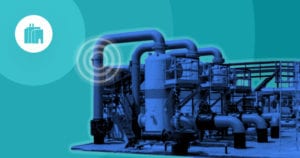
Pipelines are an integral part of the oil and gas industry, whether in upstream, midstream or downstream operations. While considered as the safest and fastest way to transport hazardous substances, these critical assets are not error-free. Under the progressive influence of material flows and dynamic environmental conditions, pipelines are susceptible to multiple structural failures. Corrosion, cracks, leakages and debonding are among the most common issues.
Besides significant product loss, pipeline leakages can cause tremendous, irreversible impacts on the environment and wildlife while threatening worker and public safety. According to a 2018 research, in the US alone, liquid pipeline accidents cost a staggering $326 million annually. $140 million of this is attributed to environmental and remediation costs. The study also revealed that it generally took 9 hours to identify an accident and another 5 hours for operators to respond.
The Challenge of Granular Asset Visibility
Facing ever-growing pressure from more stringent regulations, price volatility, aggressive environmental movements and a paradigm shift towards renewables, the oil and gas industry is forced to change. Forward-thinking companies have increasingly embraced digitalization to better manage their assets and prevent costly spills. Pipeline monitoring isn’t new in the industry, but traditional SCADA systems cannot provide the granular asset visibility needed. When it comes to hundreds, if not thousands of kilometers long pipelines, knowing what’s happening every meter is critical.
Many pipeline systems started at remote exploration sites where terrestrial networks are unreliable, or absent altogether. Monitoring options are thus limited to labor-intensive manual checks or expensive satellite subscriptions, neither of which enables data collection at the desirable granularity. Even when available, terrestrial connectivity like cellular and Wi-Fi is power-hungry while imposing expensive data plans on endpoints. This makes the cost of implementing and maintaining a large-scale monitoring network daunting to many companies.
The Internet of Things (IoT) with new sensor and communications technologies is changing the game by making asset monitoring easier and more affordable than ever. Low power wide area networks (LPWAN), in particular, introduce a low-cost, power-efficient approach to gathering granular telemetry data. Thanks to its extensive range and star topology, LPWAN can connect massive, geographically dispersed metering points with less infrastructure required. Private LPWAN is ideal in the oil and gas context as its network coverage can be flexibly adapted to companies’ specific needs at offshore and inaccessible locations.
In concert with miniaturized, multi-sensing smart sensors, robust LPWAN unlocks a wealth of critical information pertaining to the structural health of pipelines and their operating conditions. Sensor data can be forwarded to an on-site HMI for immediate counteraction, as well as a central management system and/or a cloud platform for long-term storage and analytics.
Such an IoT-enabled monitoring network can enhance oil & gas pipeline management practices in various ways to reduce costs and downtime, minimize environmental footprint and augment safety and regulatory compliance.
Accelerate Troubleshooting and Responses
Having insights into pipeline integrity around-the-clock means that any abnormalities or deviations can be instantly reported. While dropped pressure apparently indicates a leak, other sensor parameters can help identify structural issues of pipelines much earlier – before a serious spill or fatal explosion happens. For example, ultrasonic and acoustic sensors can report abnormal sound waves that suggest crack initiation and growth alongside delamination. Likewise, magnetic sensors can detect a change in pipeline wall thickness due to corrosion.
Smart sensors can communicate not only early-stage damage but also its location and severity to identify and accelerate actions required. Minimizing elapsed time between a failure and remediation is key to minimizing material losses and contamination caused by released products. Detecting damages from the start also simplifies reparation, resulting in reduced costs and downtime associated with servicing.
Enable Advanced Maintenance Strategies
By collecting data on pipeline integrity and functioning conditions over time, failures can even be anticipated and prevented with predictive maintenance strategies. Analysis of previous malfunction modes enables the development of defect growth prediction and risk assessment models. On top of that, long-term integrity deterioration assessment assists in calculating the actual remaining service life of a pipe. This allows for diagnosis of structural bottlenecks alongside strategic planning of maintenance and part replacement to circumvent damages. Predictive maintenance not only helps avoid expensive unplanned outages but also redundant planned downtime that companies with schedule-based approaches want to prevent.
Automate Manual Tasks
An IoT-based condition monitoring network lessens the need for regular field inspection and eliminates manual data logging. Besides minimizing human errors, this contributes to saving costs and improving workers’ productivity as they can focus on more important tasks. Decreased site visits, especially to remote locations, also reduce the total time of truck trips, thereby curbing fuel usage and CO2 emission.
Optimize Asset Utilization and Future Design
IoT sensor data allows companies to analyze and understand pipeline behaviors under different external conditions including structural loads, weather changes, soil characteristics, moisture and pH levels. This information is instrumental in improving future engineering and construction practices to optimize the effective service life of a pipeline. Furthermore, for older pipes that have been in service for several decades, sensor data can validate their integrity for continued safe operations.
The advent of IoT enables unprecedented asset visibility that goes beyond the capability of conventional industrial networks. Deploying an IoT solution doesn’t necessarily require significant upfront investment or dangerous, cumbersome alterations in brownfield systems. Emerging wireless solutions like LPWAN and new sensor technologies can be easily retrofitted to IoT-enable critical legacy assets like pipelines at low costs. More importantly, the immediate impact of an IoT monitoring network on operational efficiency, safety and sustainability will soon outweigh the initial costs and advance companies’ competitive edge in the oil & gas marketplace.





 Related Podcast Episode
Related Podcast Episode




 Related Applications
Related Applications


 Latest IoT News
Latest IoT News








